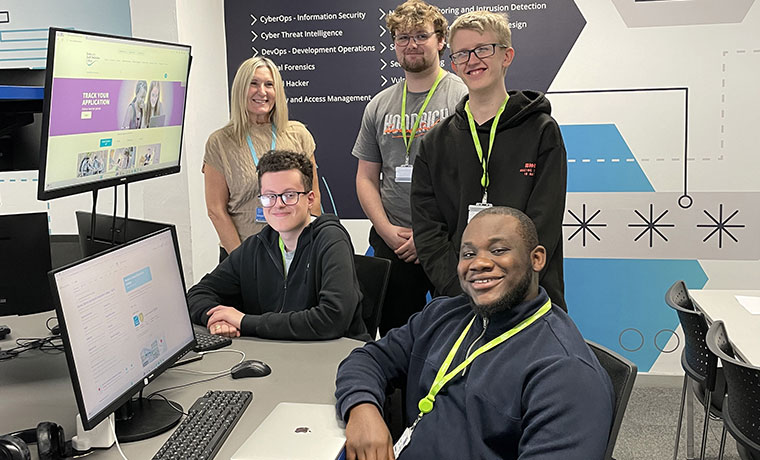Technology is critical to making hybrid learning a success

Innovations in video conferencing will power the Higher Education institutions of the future
In the past two years, the further and higher education sectors have experienced transformation at a pace and scale never witnessed before. Lecturers and seminars moved from in-person to online in a matter of days, with teachers and students quickly getting remote setups together. The priority was ensuring that effective learning could continue with minimal disruption.
Now, the sector has adjusted to a new style of learning, which is more hybrid and incorporates both in-person and remote participants. Priorities have shifted towards delivering remote education in a way that mirrors the in-person experience as closely as possible, and means that quality learning happens no matter where students and teachers are based.
What the pandemic taught us is that learning can happen almost anywhere, as long as students and teachers have access to great digital learning tools – from video conferencing systems that make hybrid lessons seamless, to innovative tools like AI whiteboard cameras that level the experience for both classroom-based and remote learners.
Powering seamless collaboration for hybrid learning
The priority for all students, regardless of where they are working, is that they can learn effectively and reach their full potential. This requires the ability to easily access resources, actively take part in discussions and develop quality relationships with their peers and teachers. When learning takes place in a hybrid environment, all of this relies on quality video and audio solutions.
Education institutions need video conferencing systems that allow students to see one another face-to-face and participate and contribute equally from wherever they’re learning.
For example, through AI technology, video conferencing systems are now able to detect which participant is speaking and zoom in on them, whilst also auto correcting colour and exposure, ensuring an optimal seminar or lecture experience for all participants. Similarly, adaptive beamforming mics ensure that every individual in the room can be heard, and this kind of solution is becoming much more widely adopted across higher education institutions (HEIs).
Video suited for every space
Choosing the right type of video solution also depends on the kind of learning space – from the size of a room to how it will be used. In a more hybrid world of learning, this ranges from private studying spaces at home, to small seminar rooms and large lecture theatres. Each of these spaces serve a different purpose, and need different video solutions and peripherals too.
For personal workspaces, external webcams are important to offer face-to-face interaction, even when students can’t work together in the classroom. Quality headsets that can also be useful to cancel out noise and optimise productivity are also key, as well as ergonomic mice and keyboards that make desk work more comfortable.
For seminar rooms, video solutions designed for ‘huddle rooms’, with a wide angled field of view and excellent audio and optics allow every participant to be both seen and heard clearly are a great option. Larger rooms and lecture theatres will benefit from a powerful camera and solution that can take expansion microphones, so everyone in the room can be heard.
As technology advances, more innovative solutions are also coming to the market. For example, we’re now seeing tools like AI-powered whiteboard cameras that can offer an unobstructed, clear, real-time view of the whiteboard for remote lesson participants. By levelling the experience for those in and out of the room, it’s possible to ensure remote learners aren’t disadvantaged.
Reducing barriers to installation and adoption
Any conferencing and collaboration tools also need to be simple to install and use, to reduce barriers to adoption and ensure a HEI’s investment is maximised. This is where ‘one-touch call’ solutions will be especially valuable, as well as software that is compatible across a vast range of platforms and devices to cater to student needs. Many students may be attending with varying devices and working across multiple platforms – and a HEIs equipment needs to be inclusive of that.
HEIs also often need equipment installed and operational in days rather than weeks, and equipment that can be installed by IT generalists. To support this, AV solutions need to be not only easy to use when up-and-running but have features like exceptional cable management to prevent time wasted searching for the right port on installation and operation.
Networked device management systems can also be an effective way for IT teams at HEIs to get a view of a whole video estate, sharing insights on any errors that may need fixing and pushing updates when needed – and make sure the equipment keeps working effectively.
Final thoughts
Hybrid learning comes with challenges, but it can be very effective when done right – and video conferencing technology is central to this. From ensuring it is possible for in-person and remote learners and teachers to collaborate seamlessly to levelling the learning experience for everyone, technology is critical to make a new type of learning a success in HEIs.
Chris Hopkins, Public Sector Education Specialist, Logitech
You can find Logitech for Education showcasing its array of innovative solutions for schools and higher education at Bett 2022 (23rd – 25th March), at stand number: SJ41












Responses